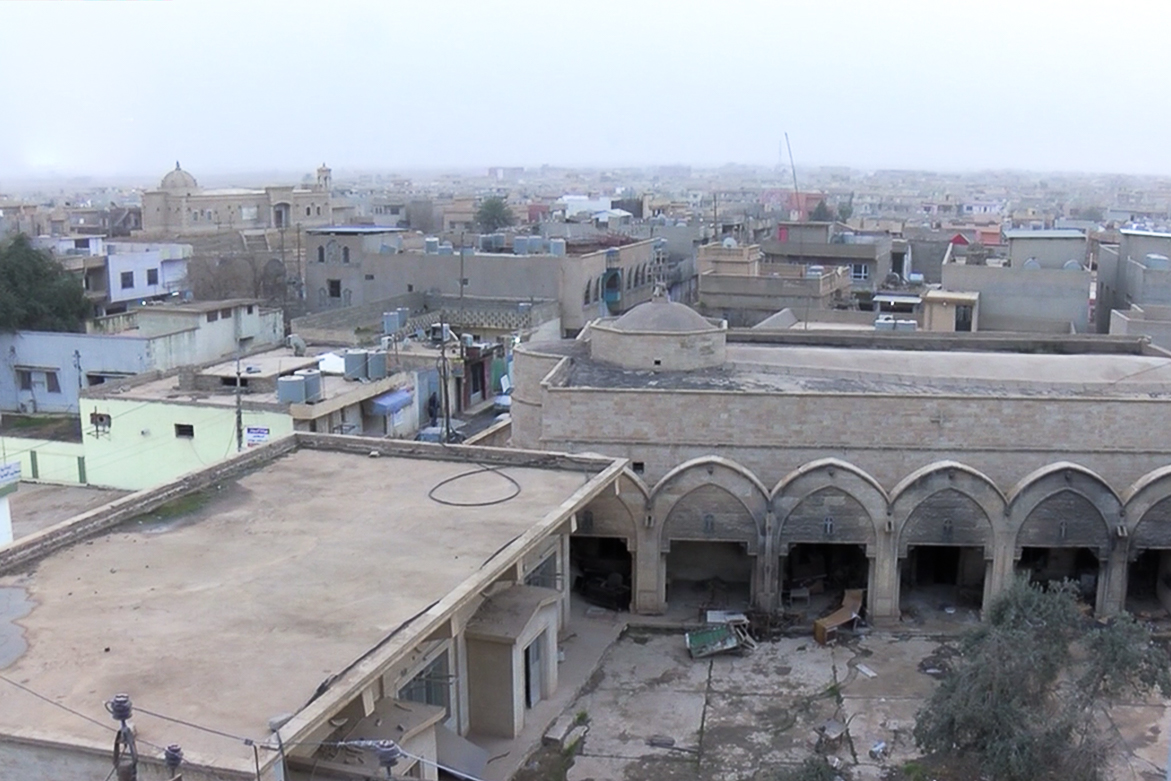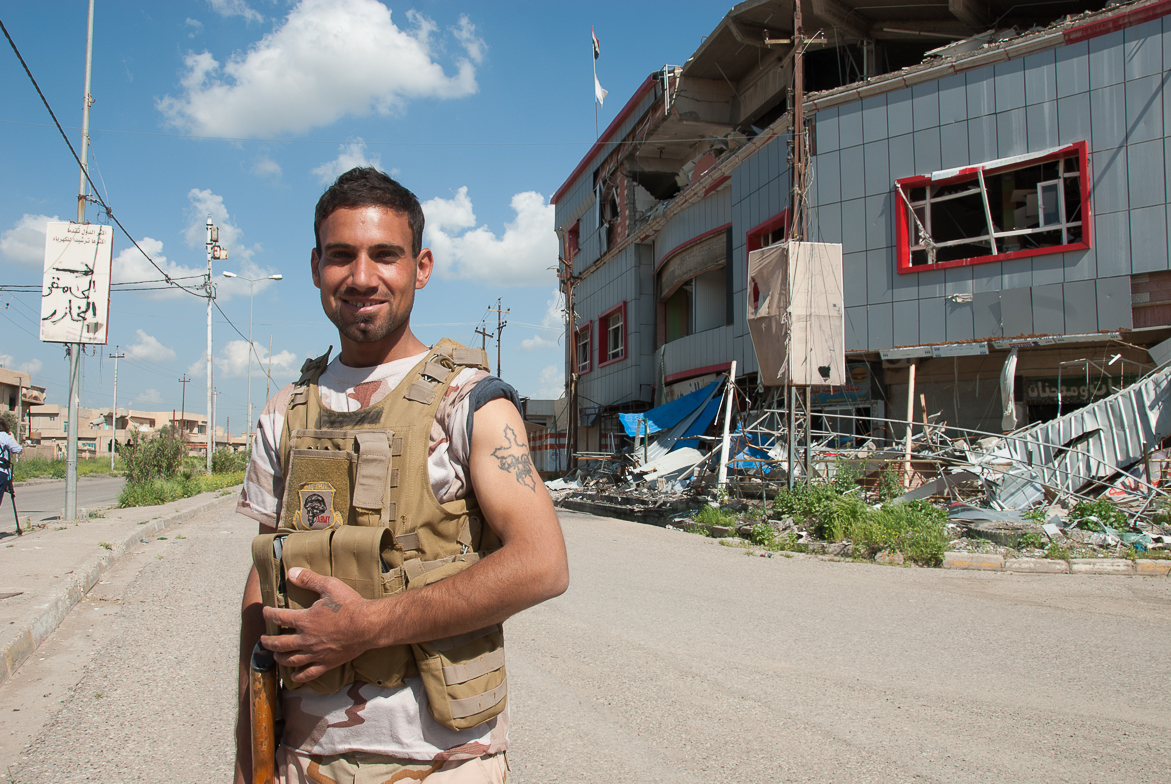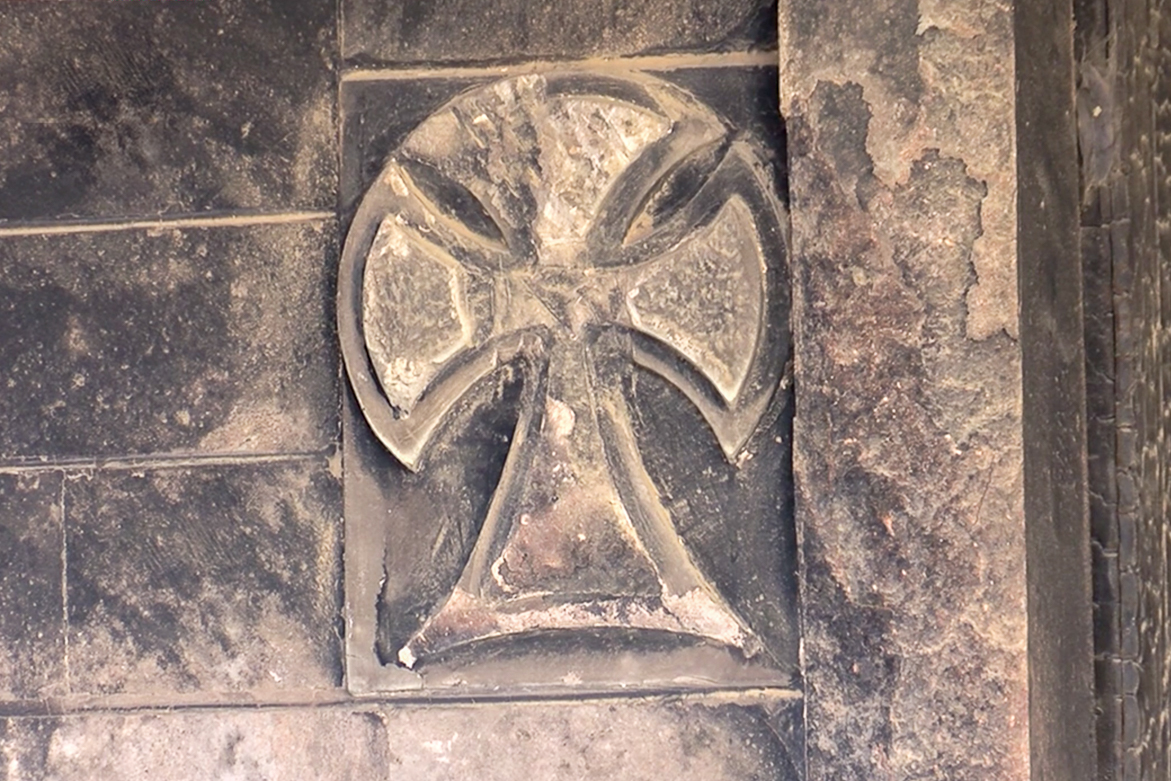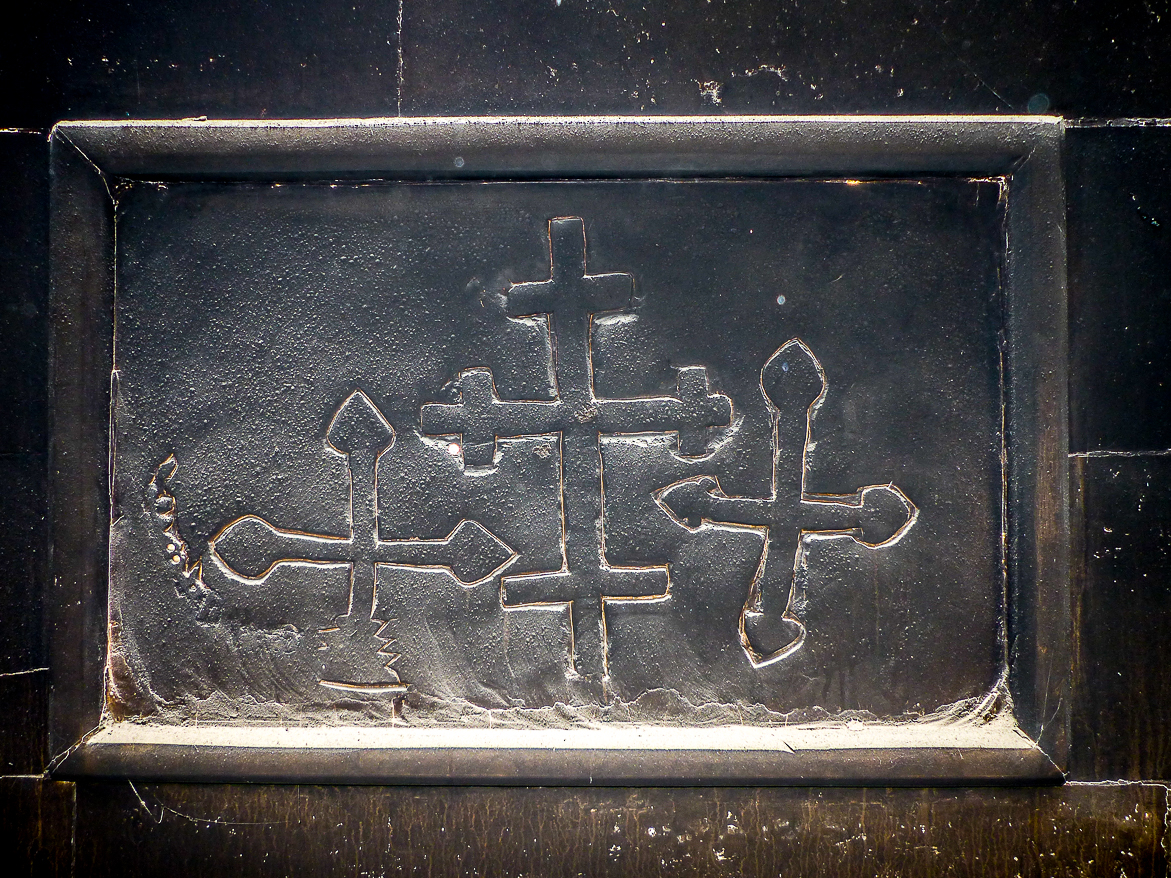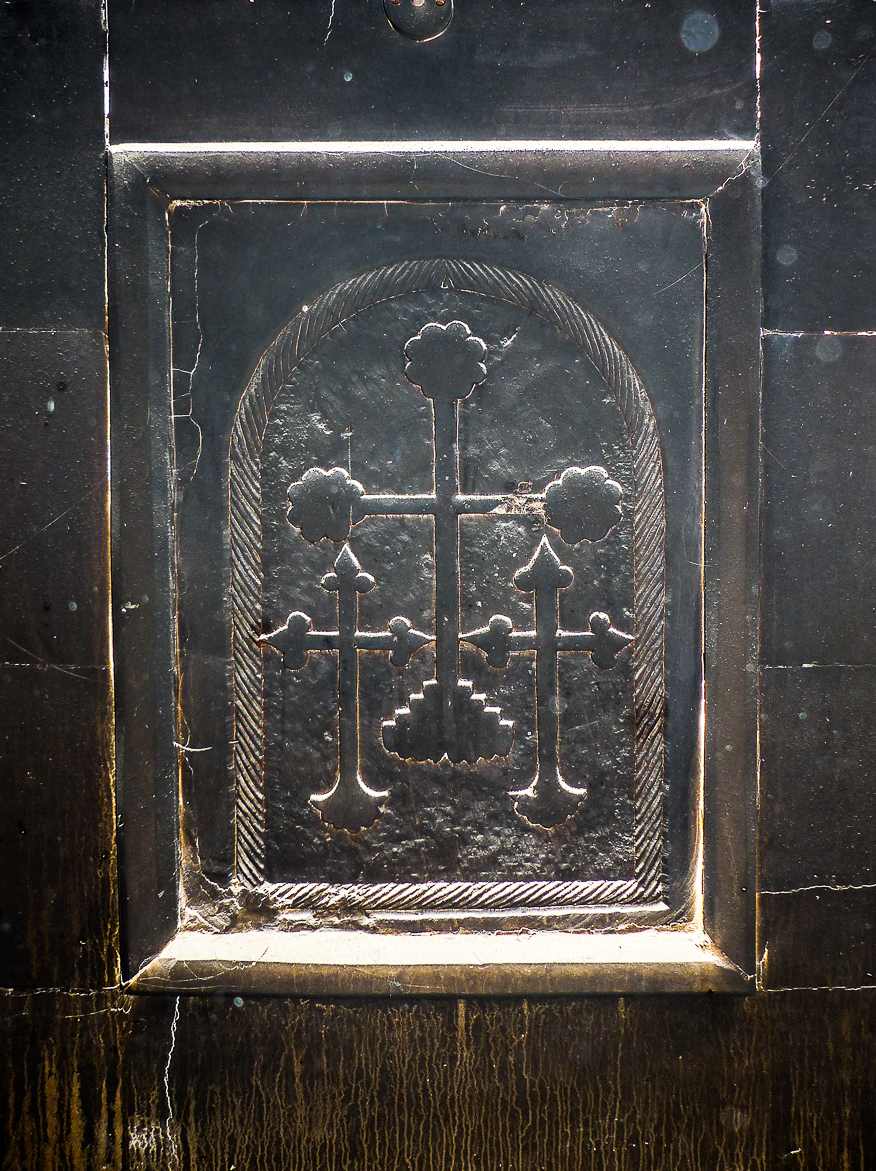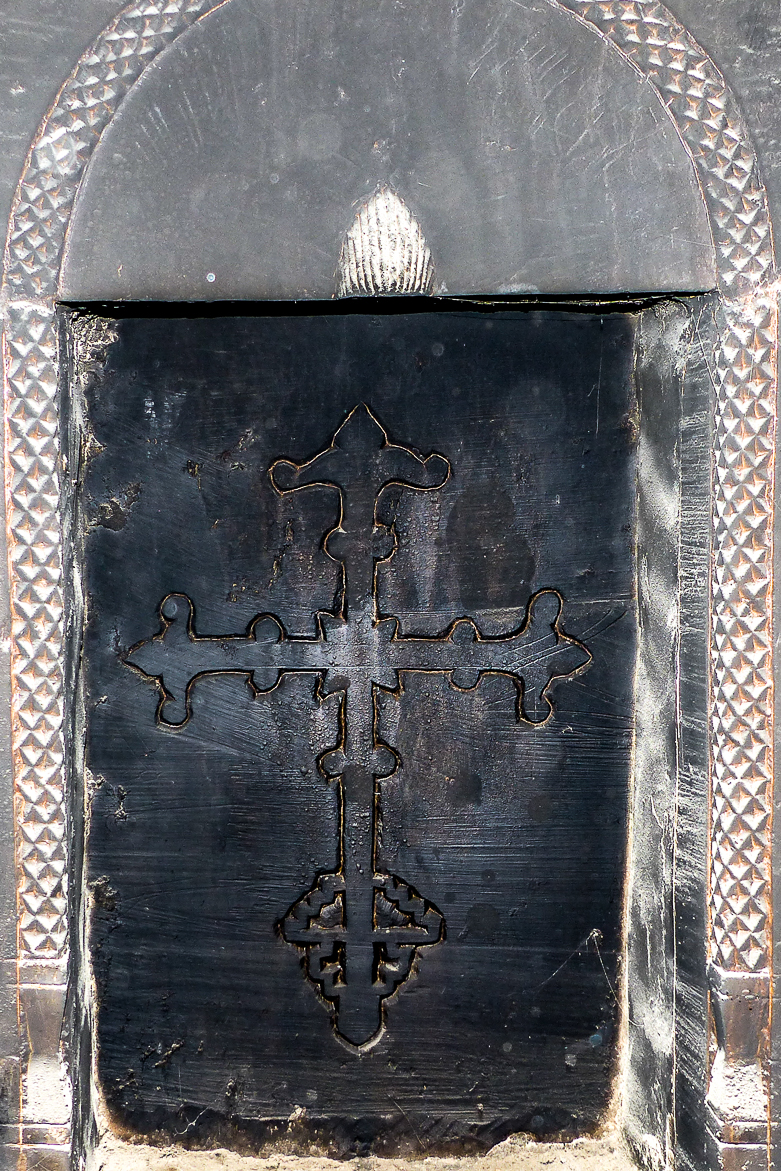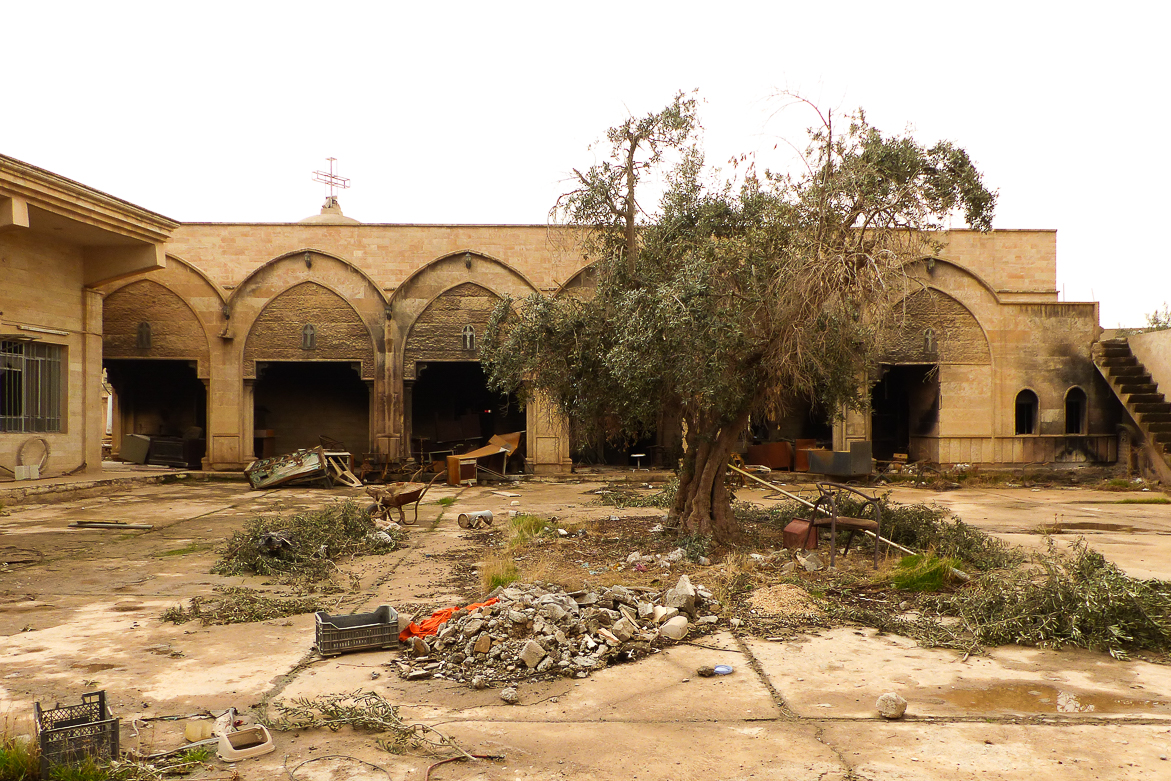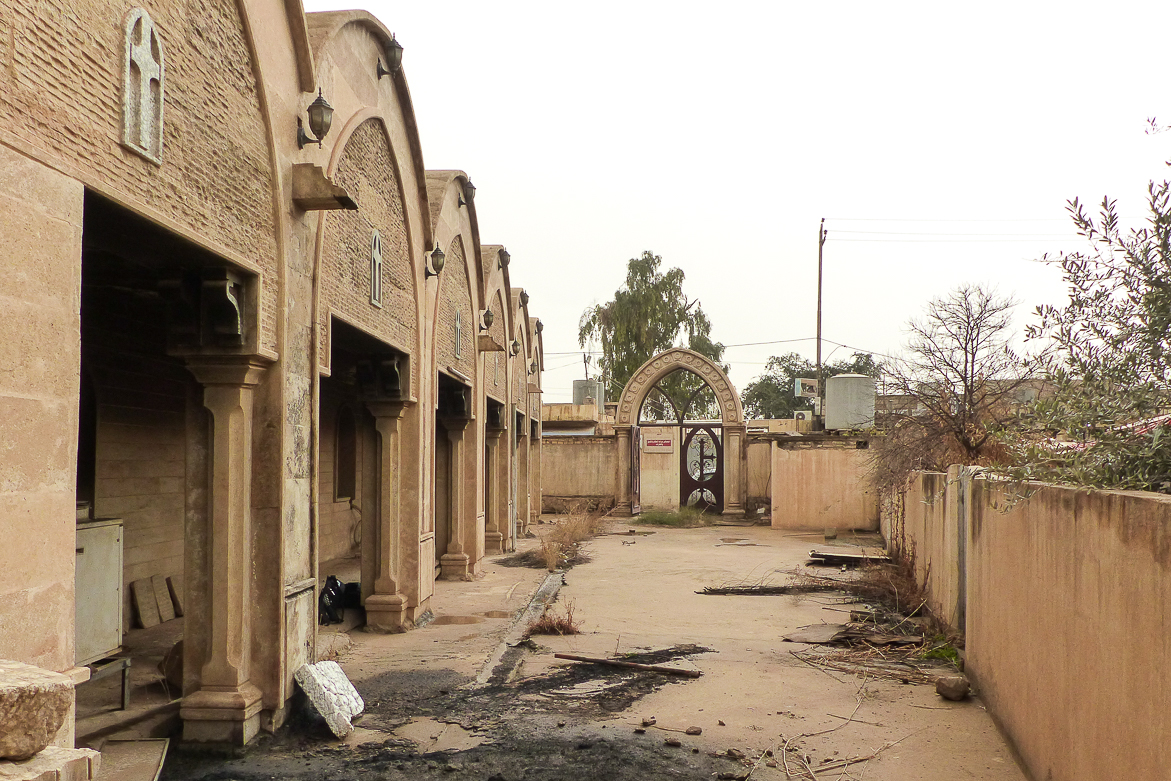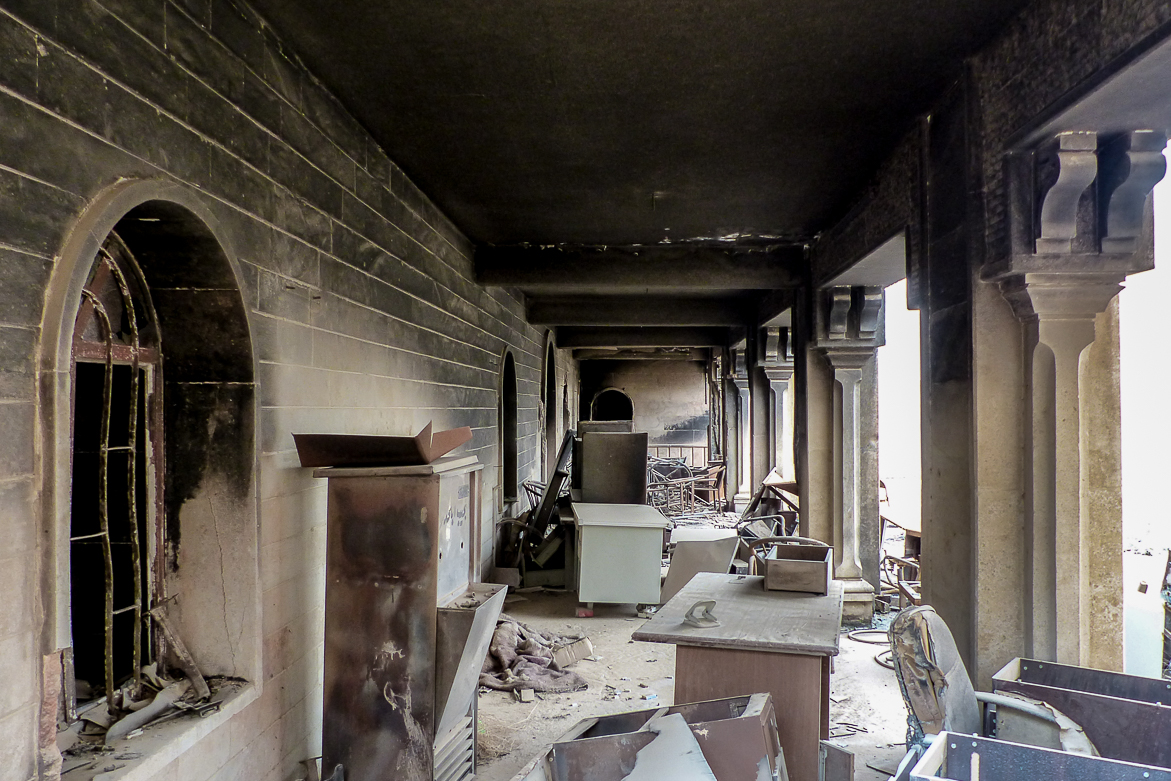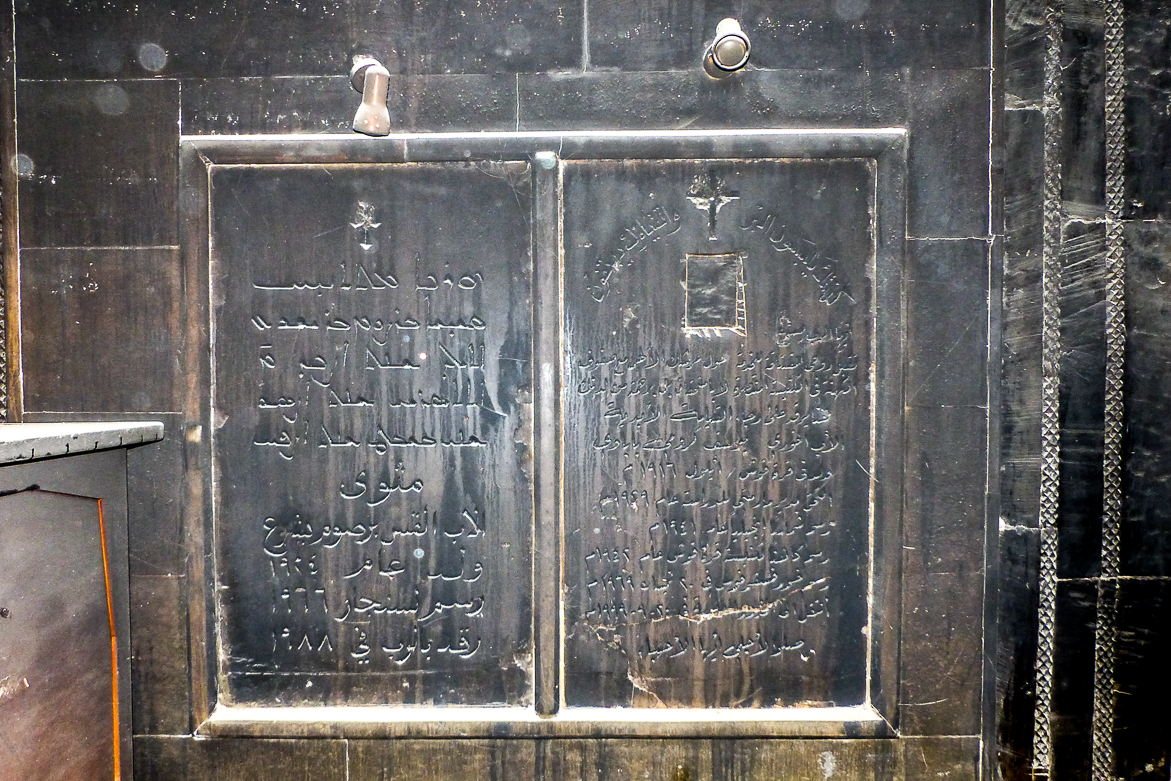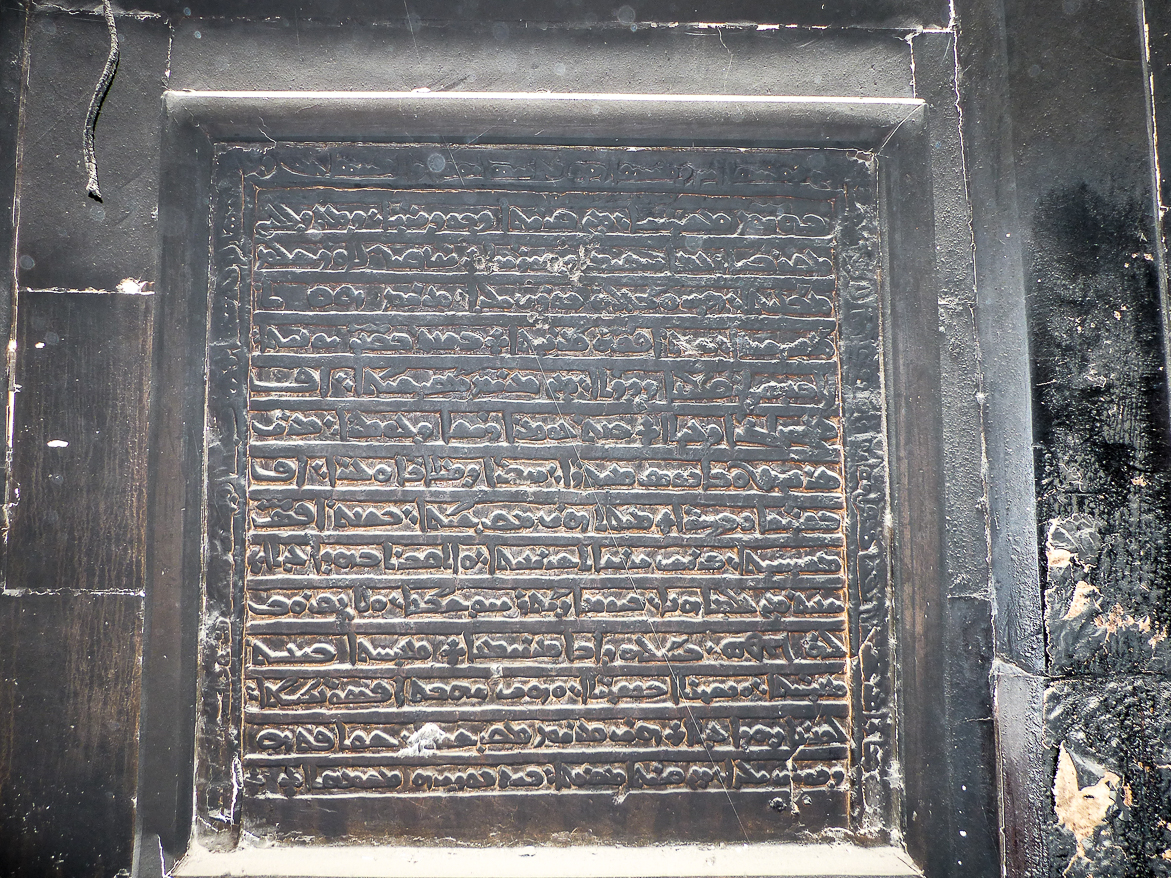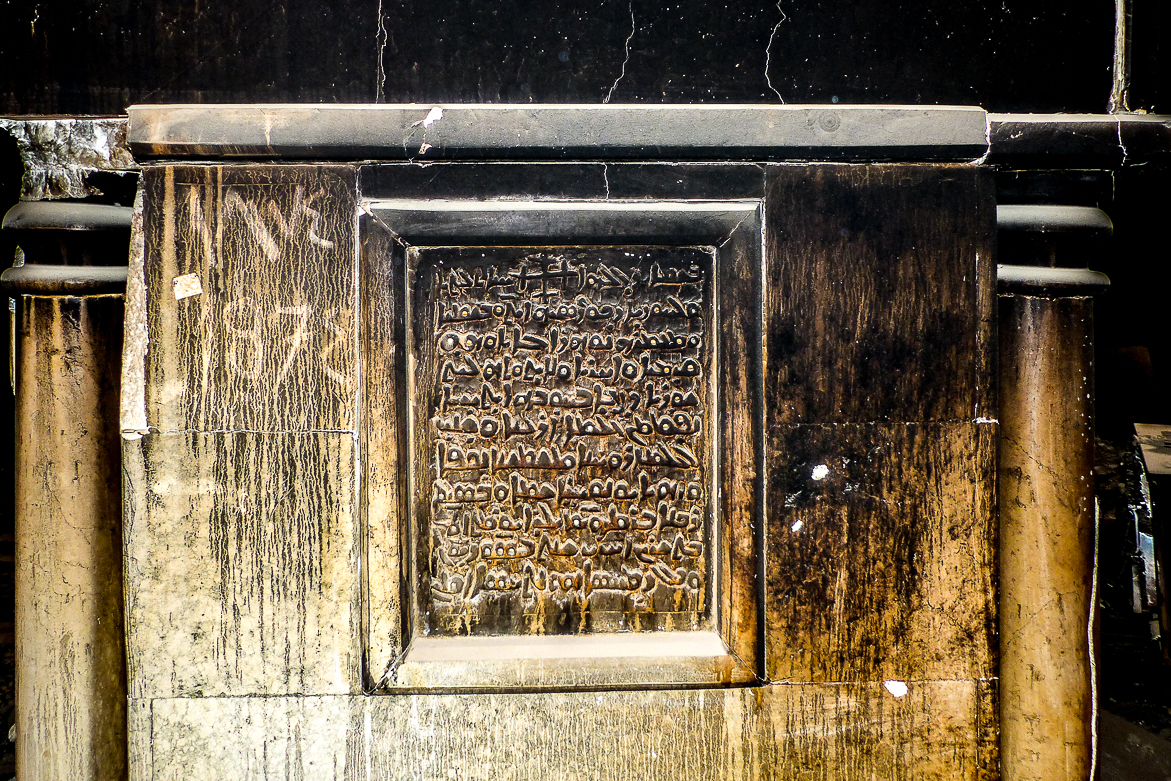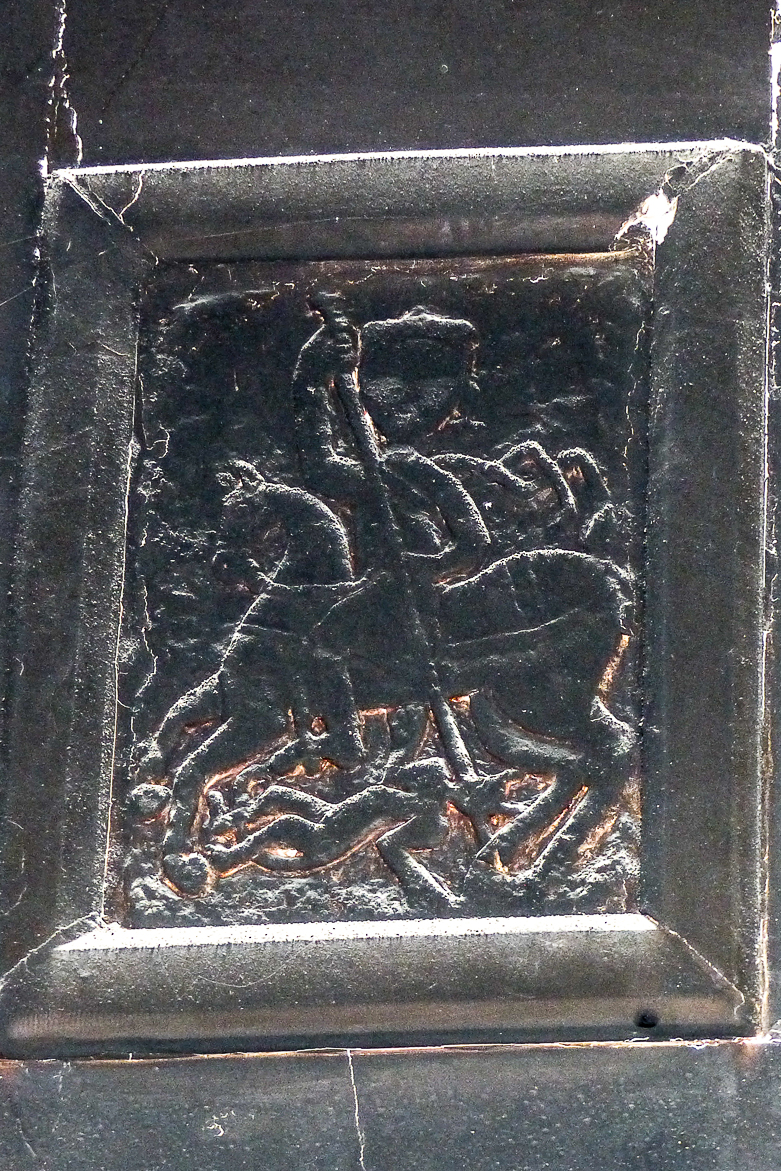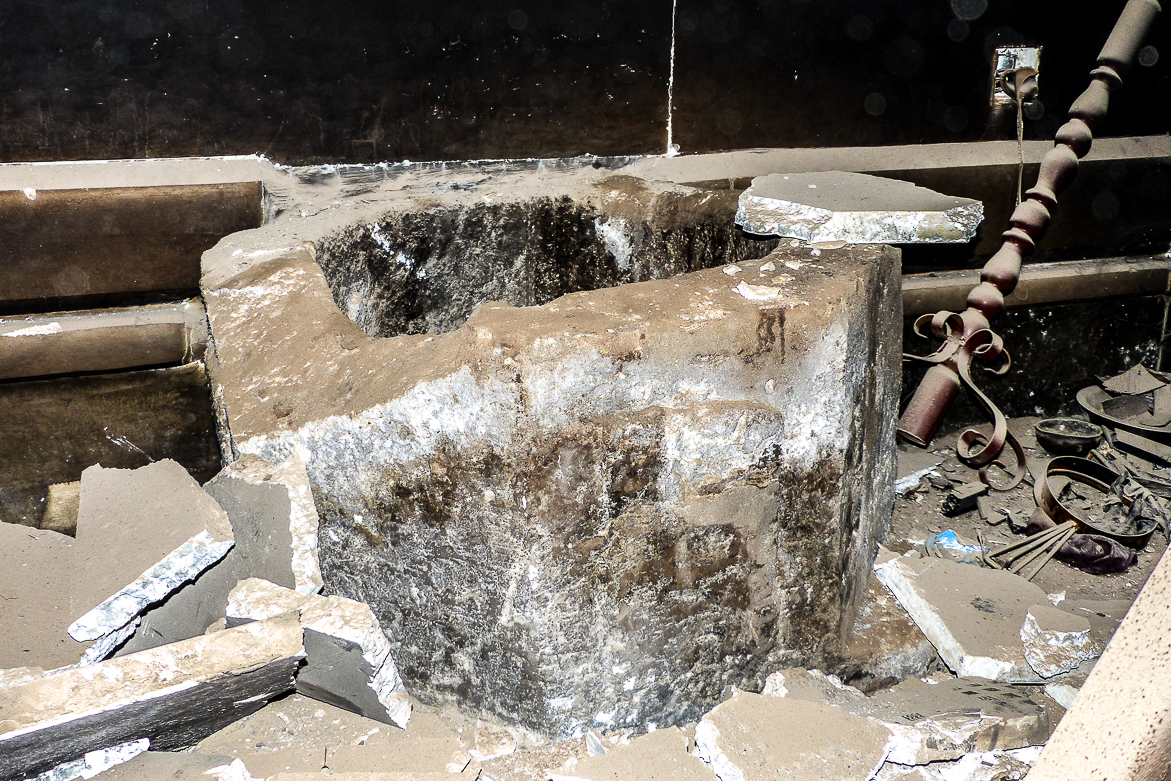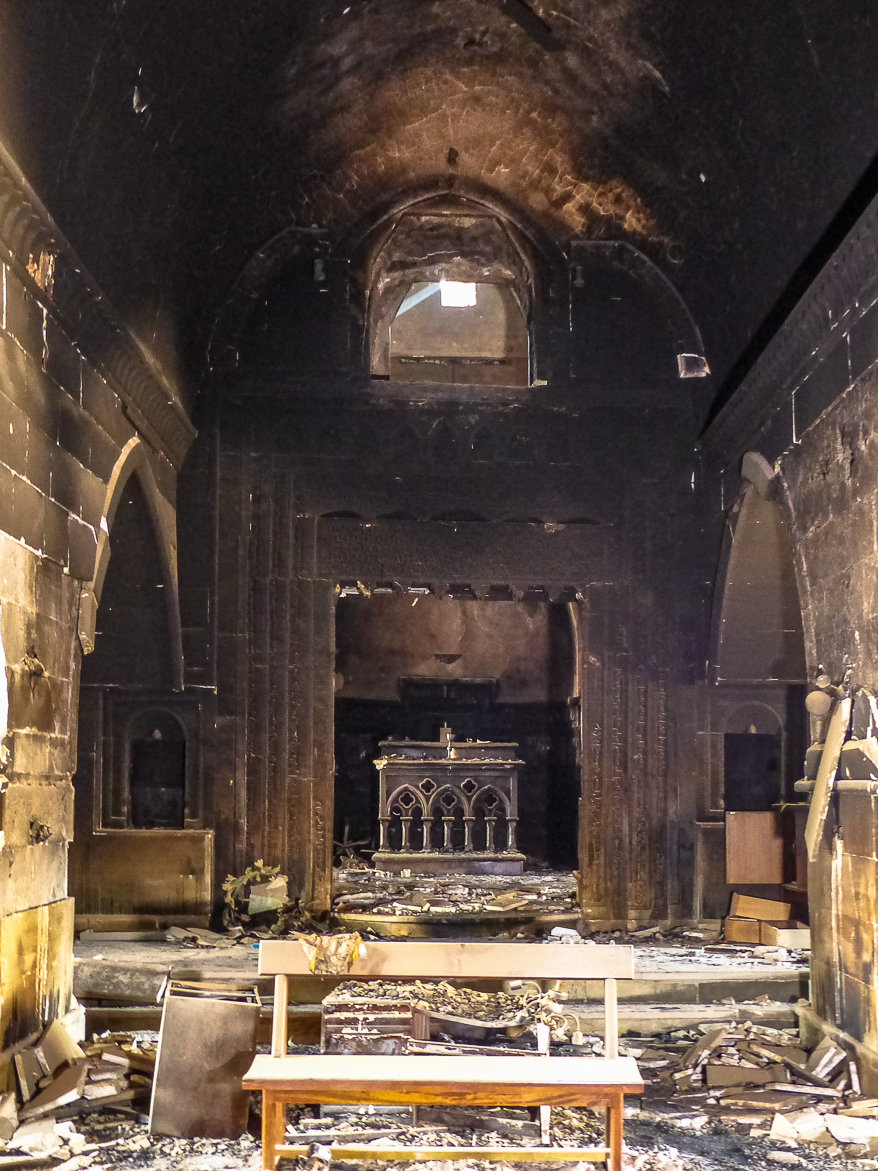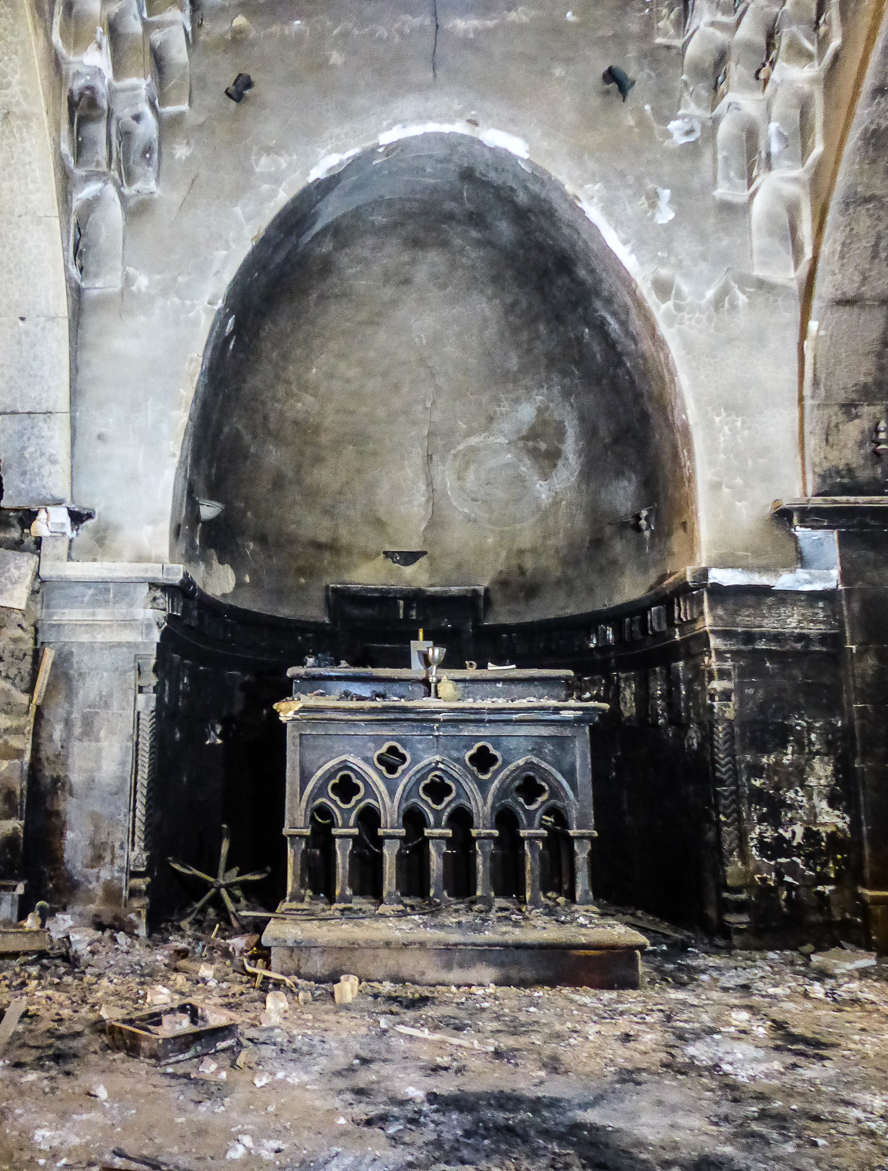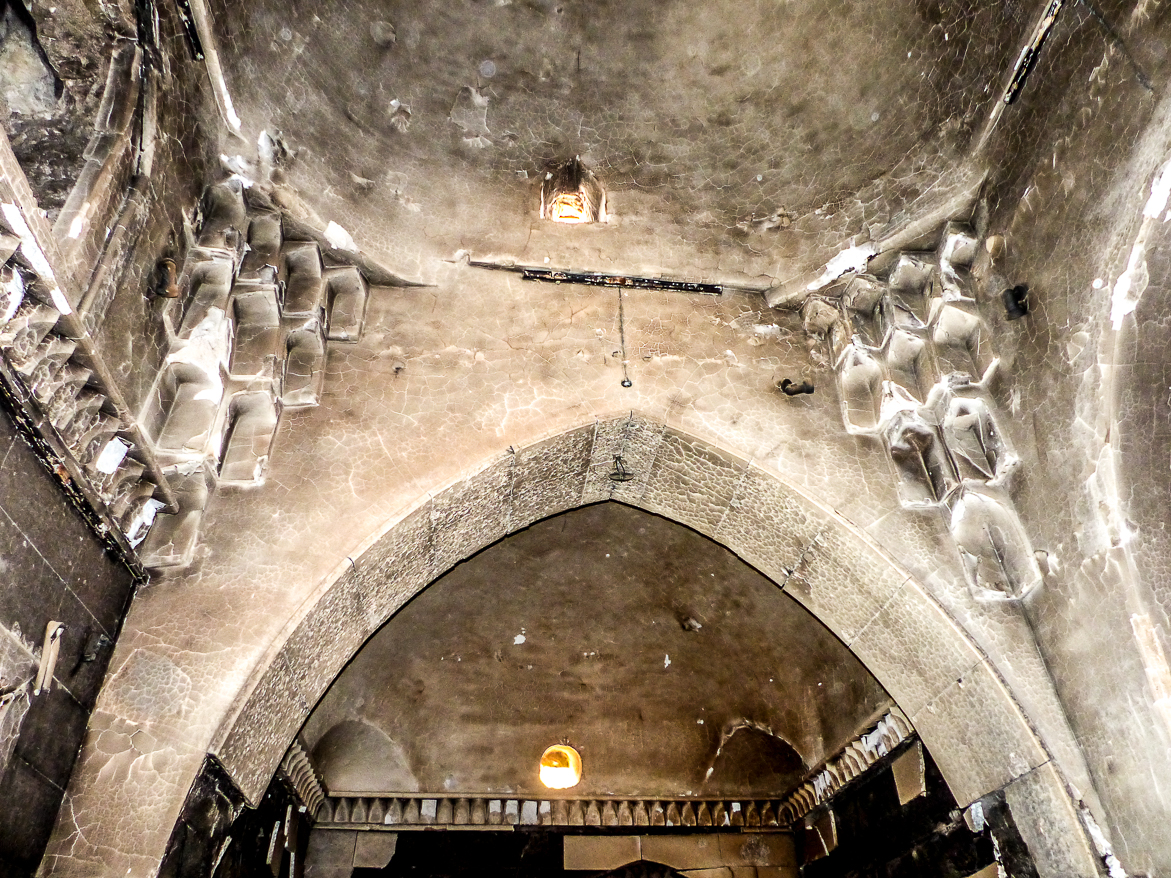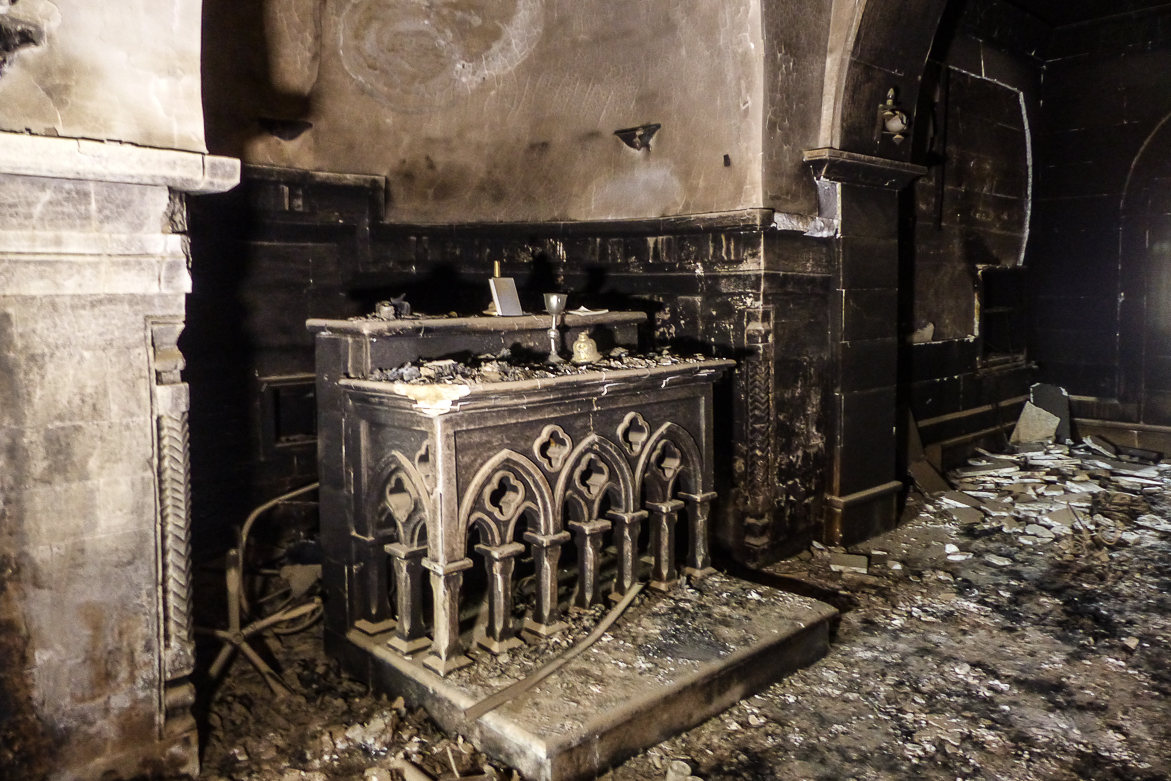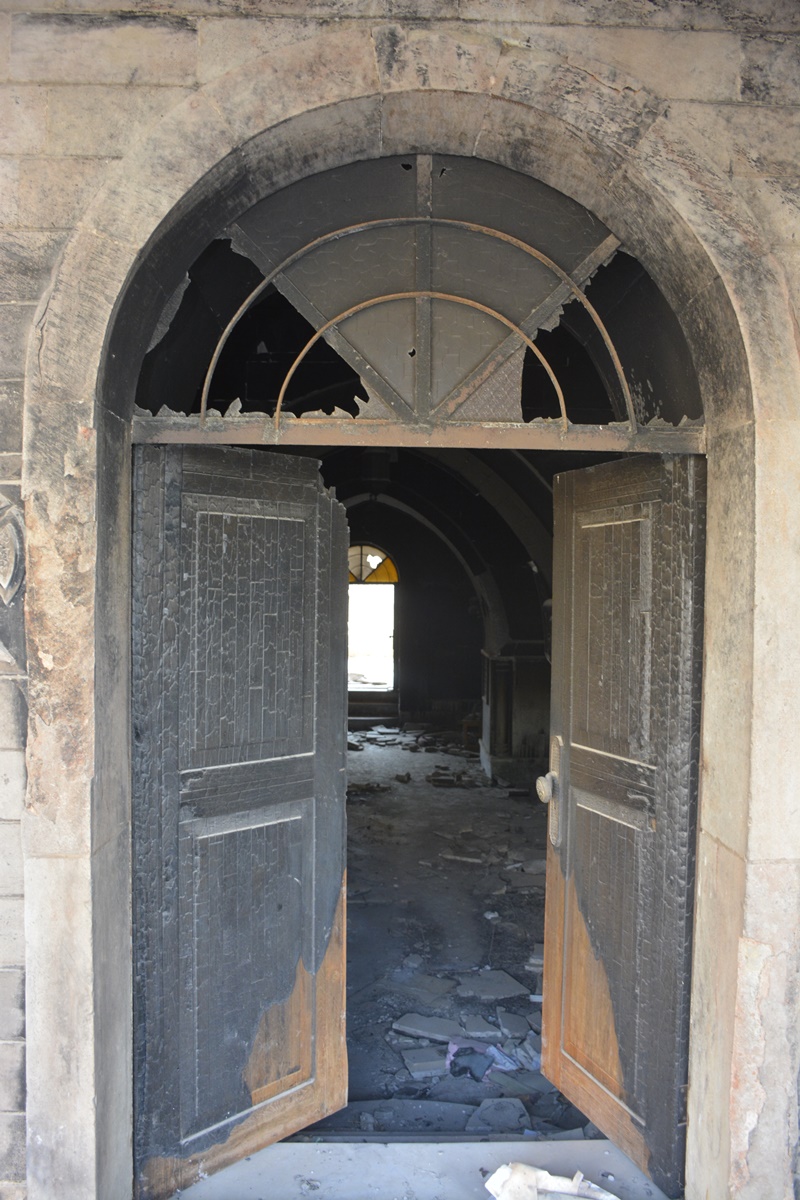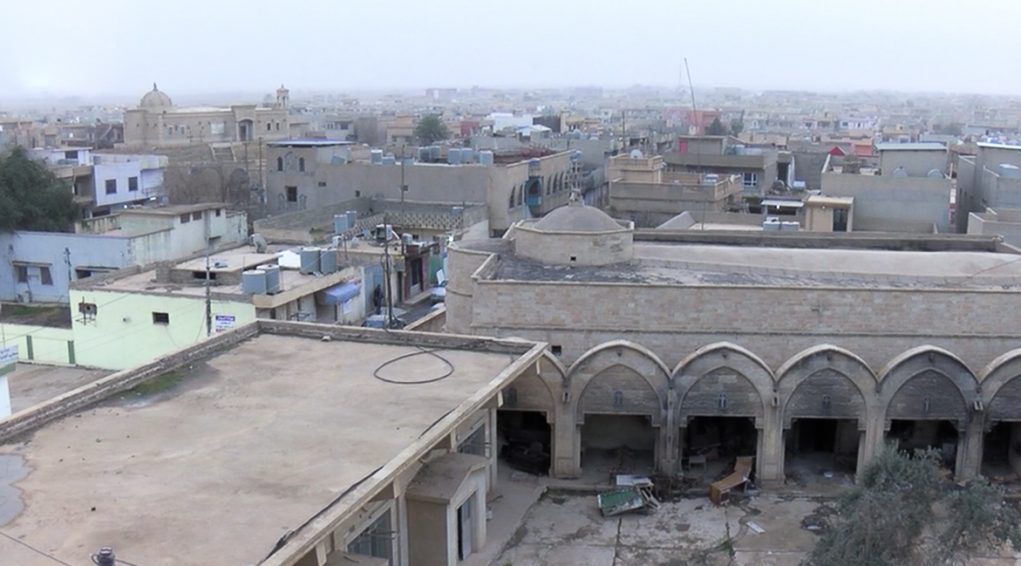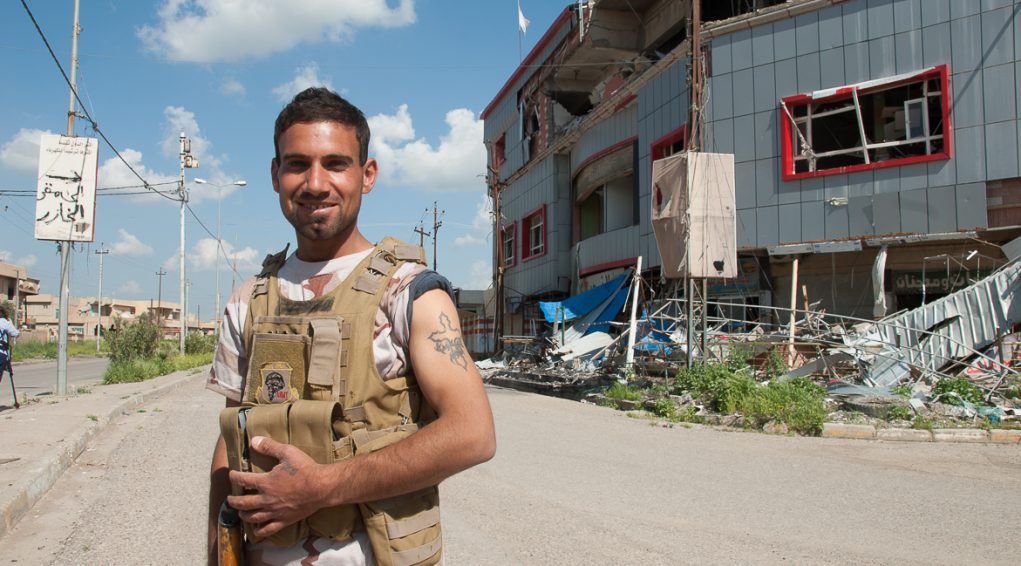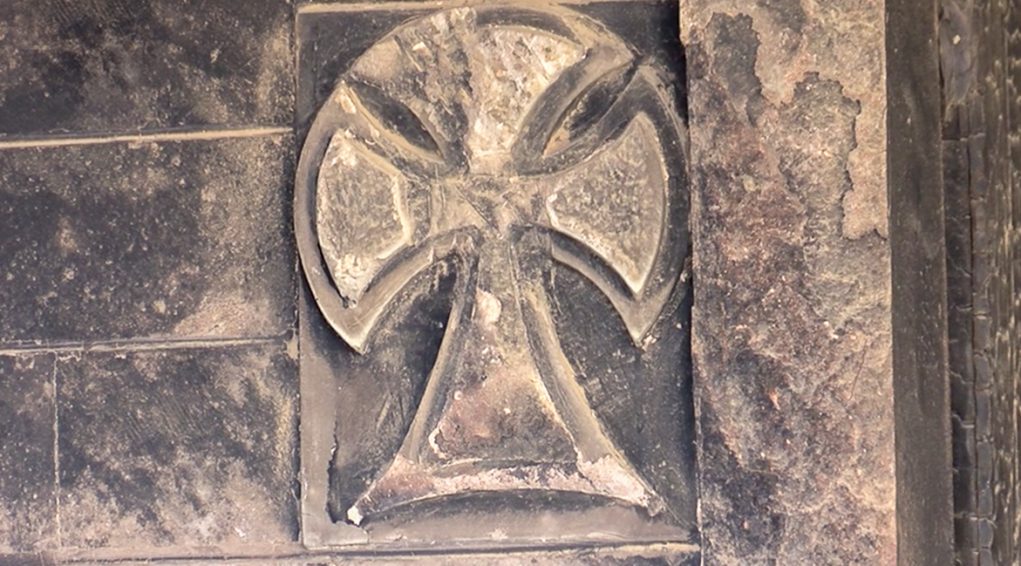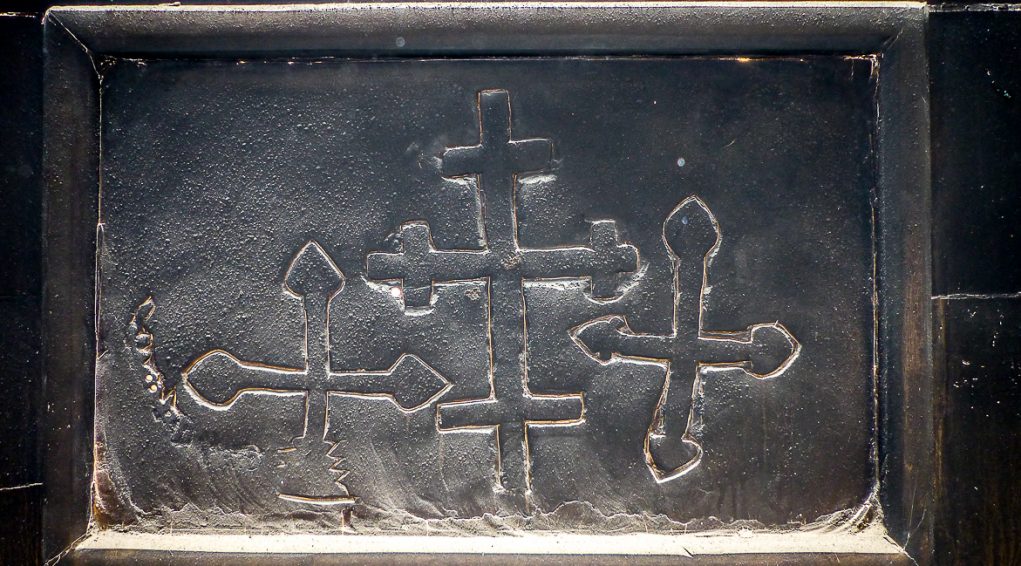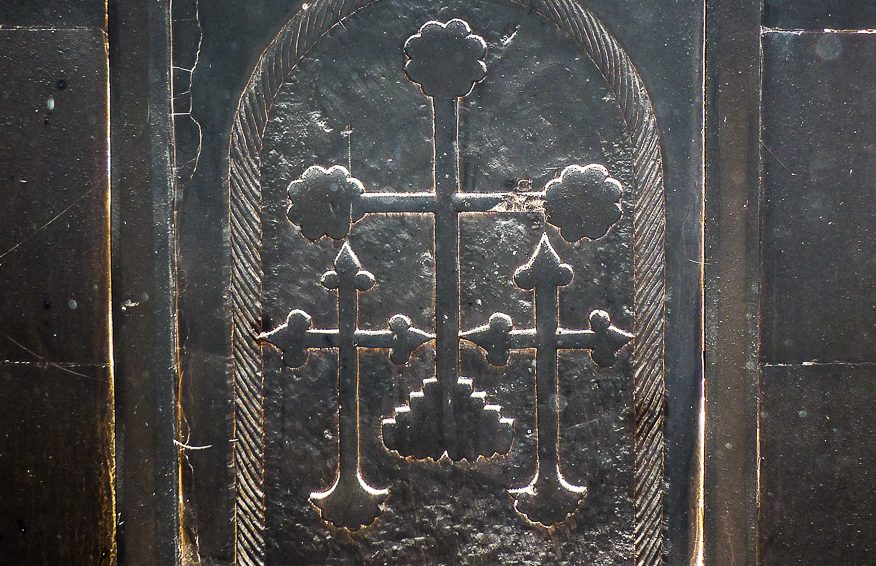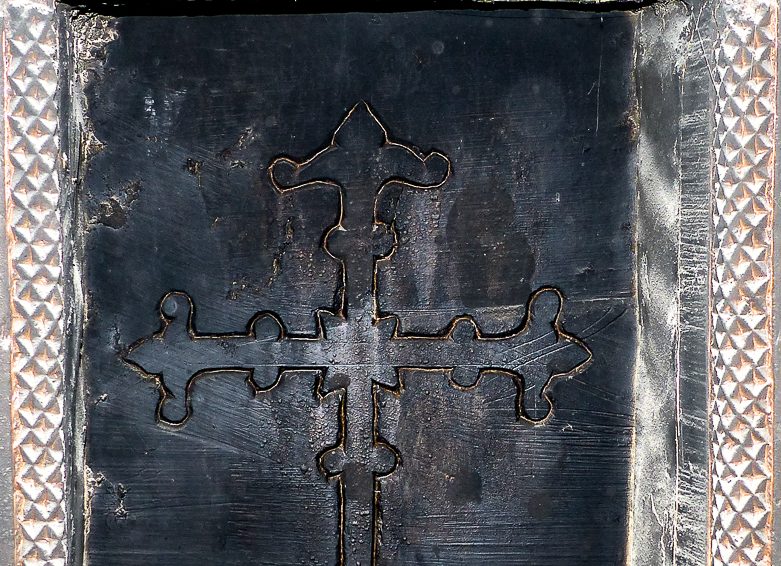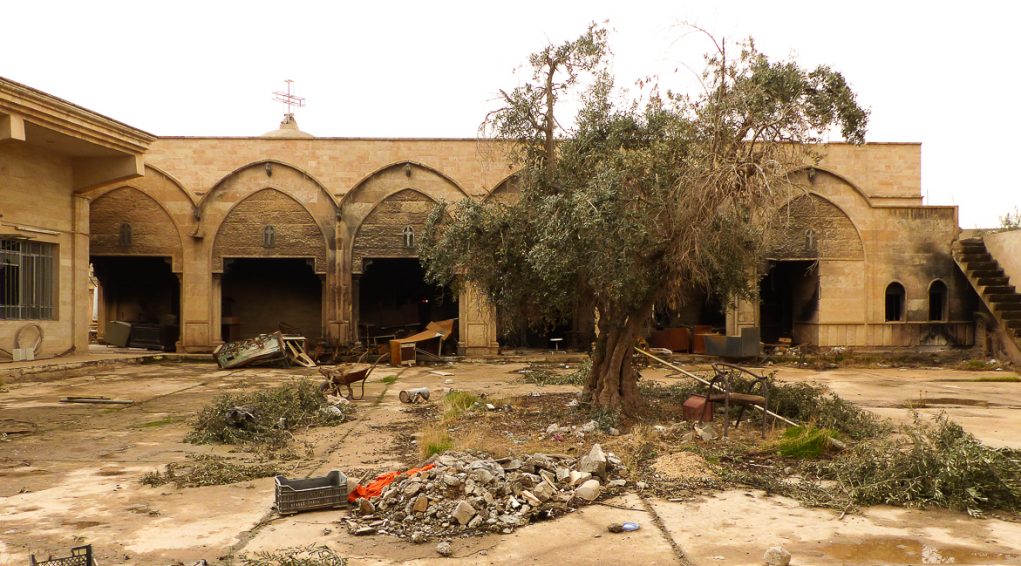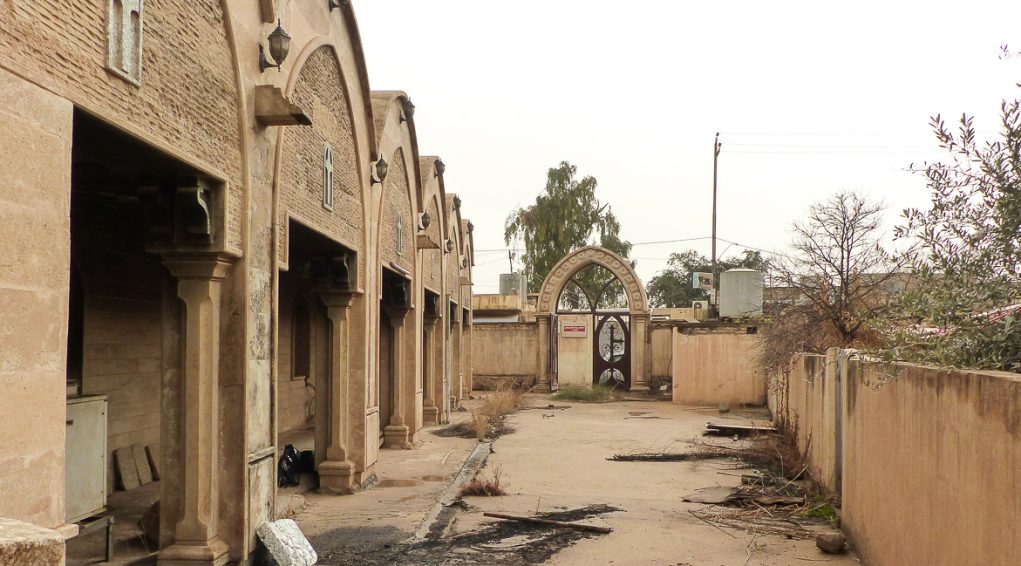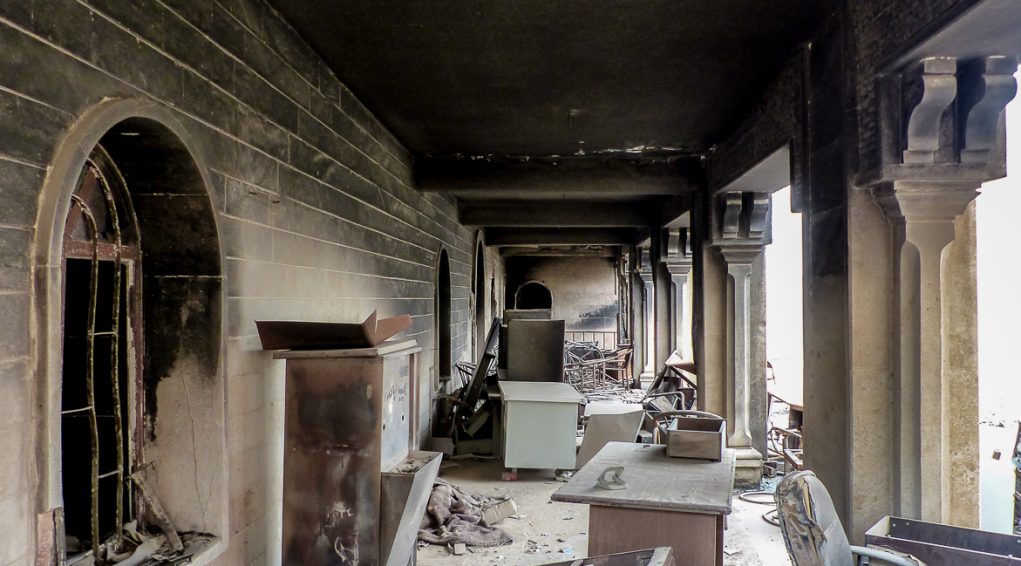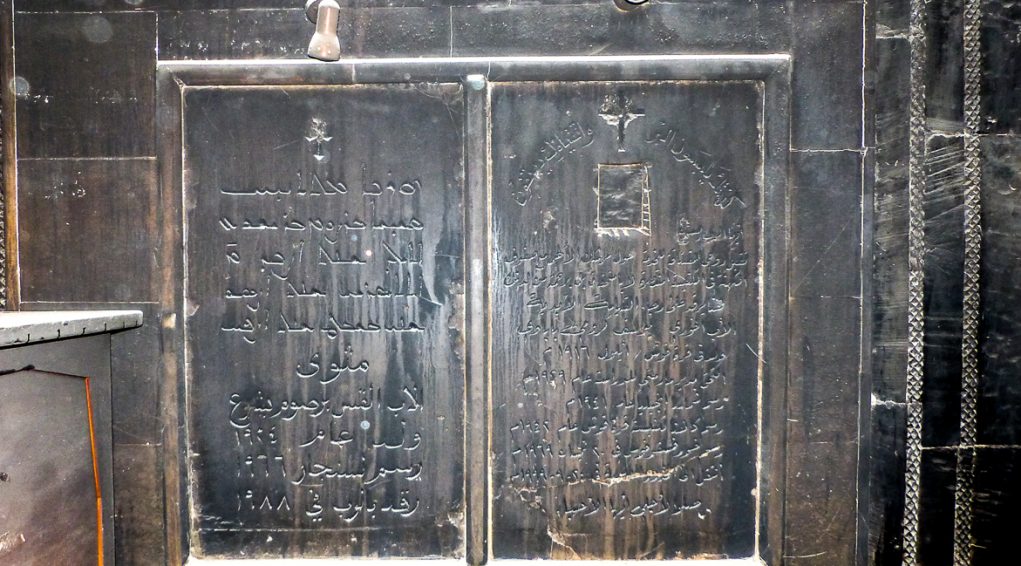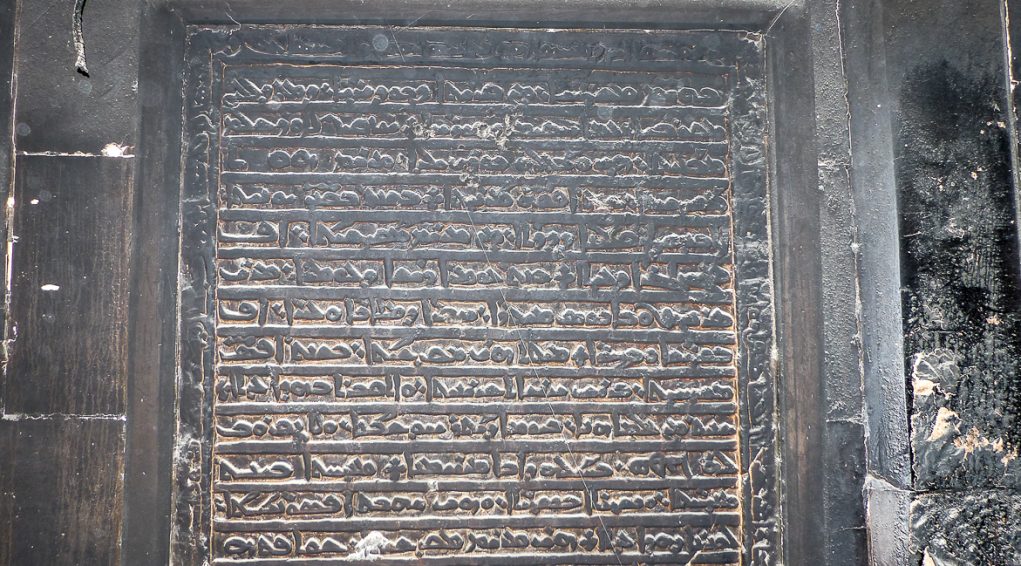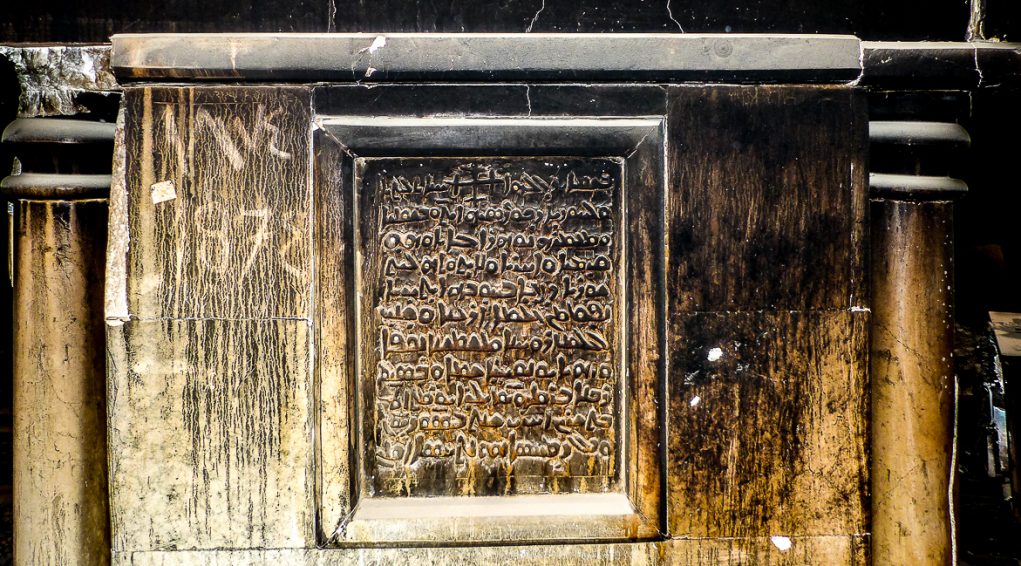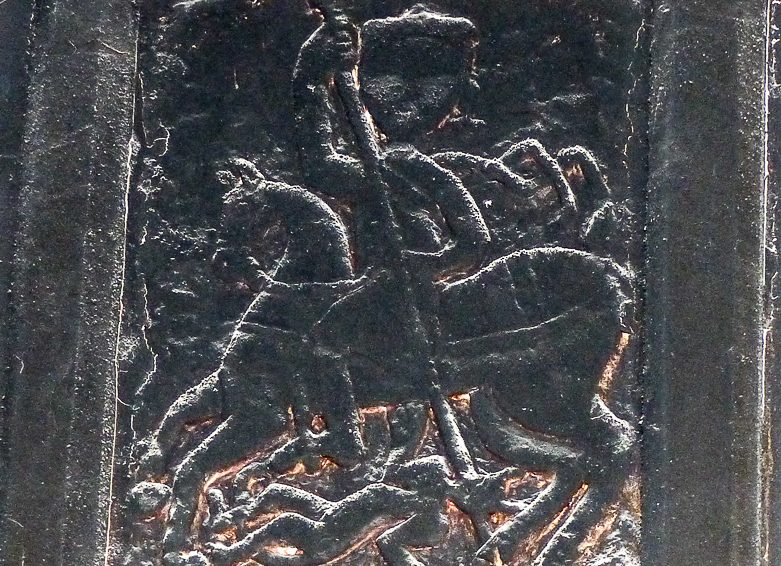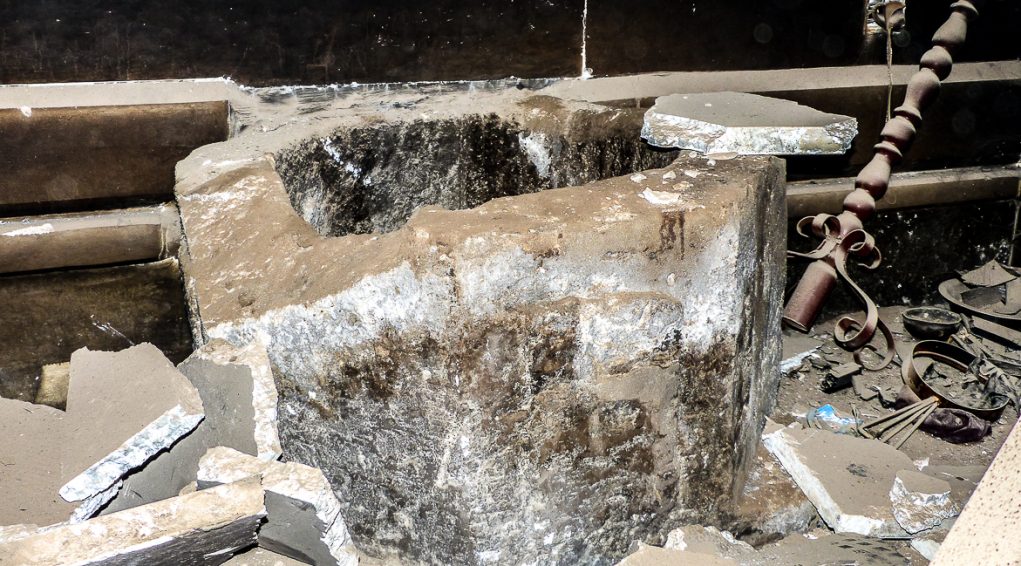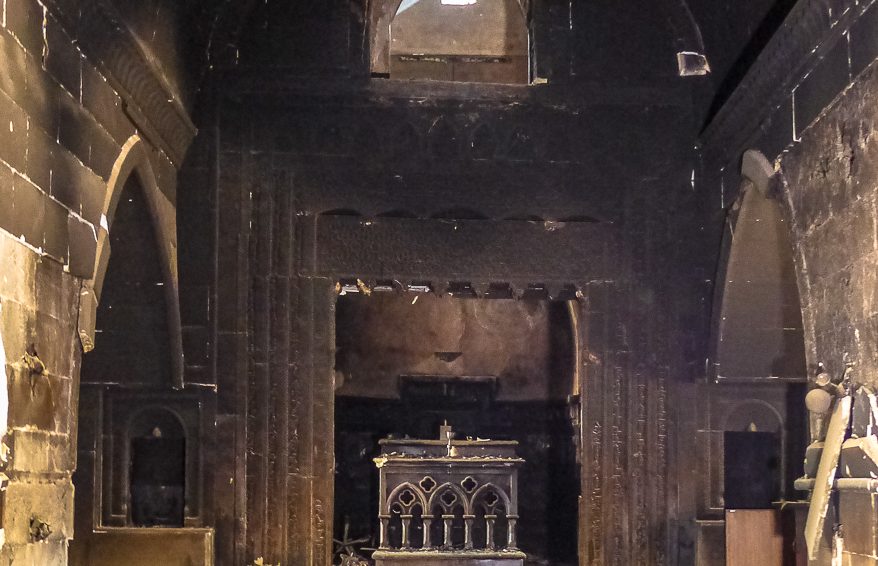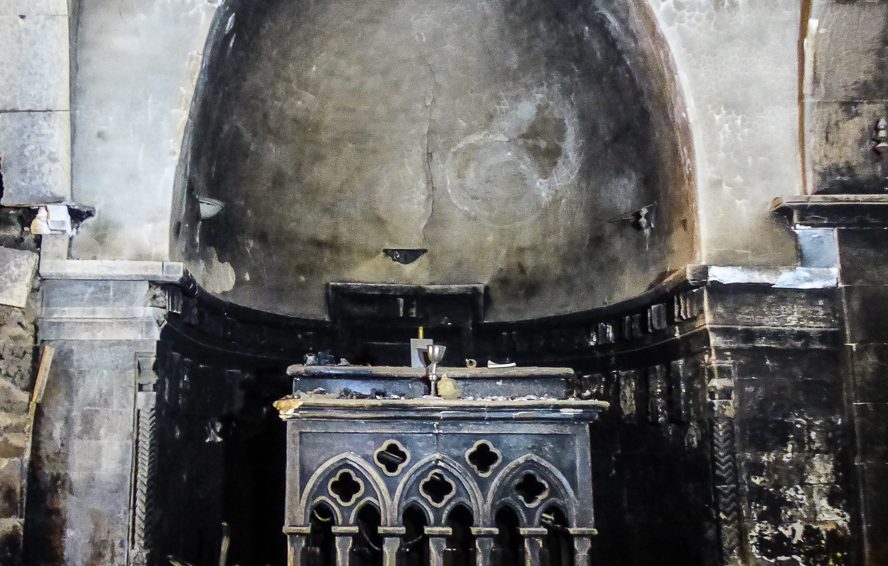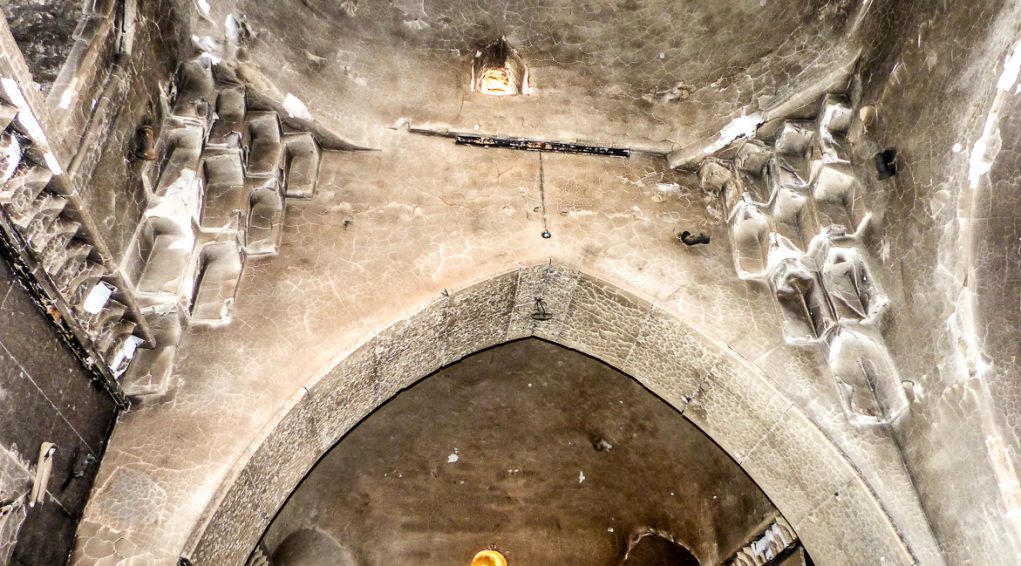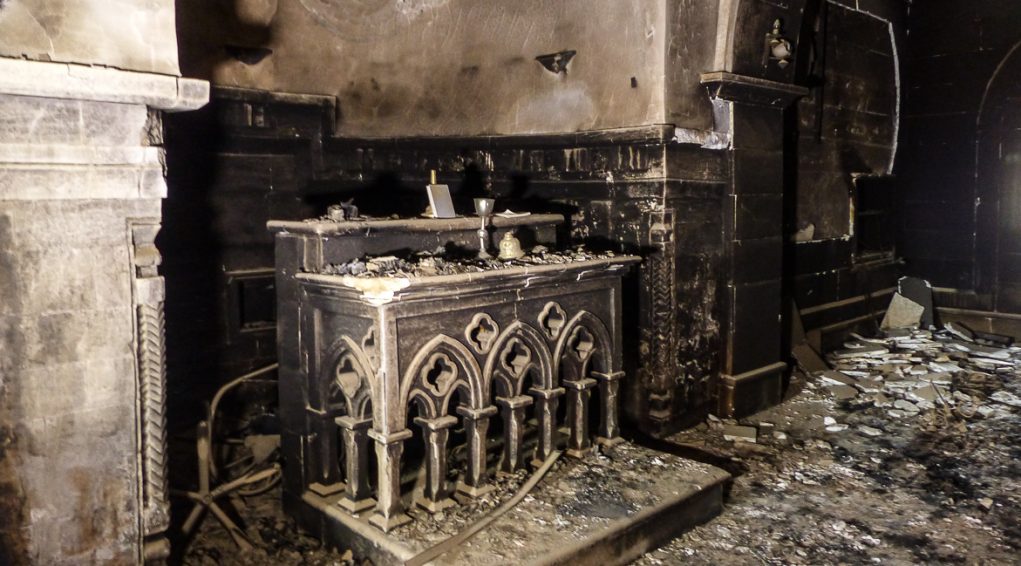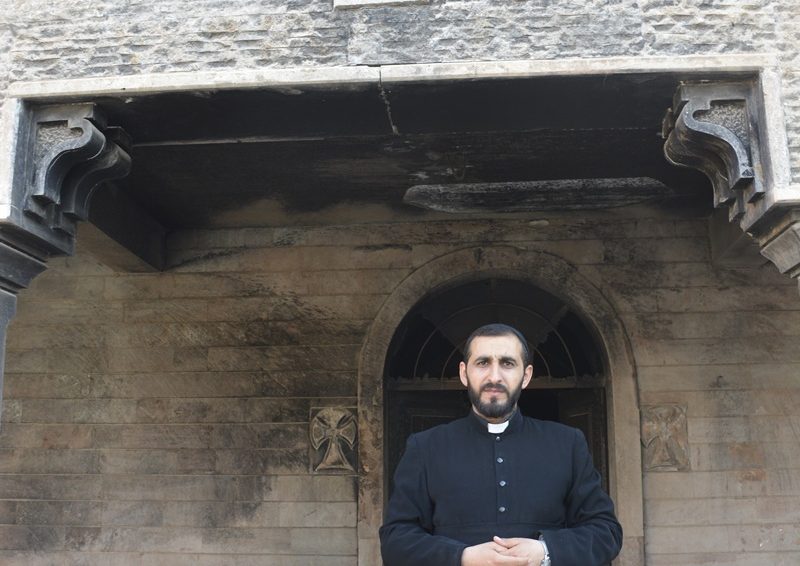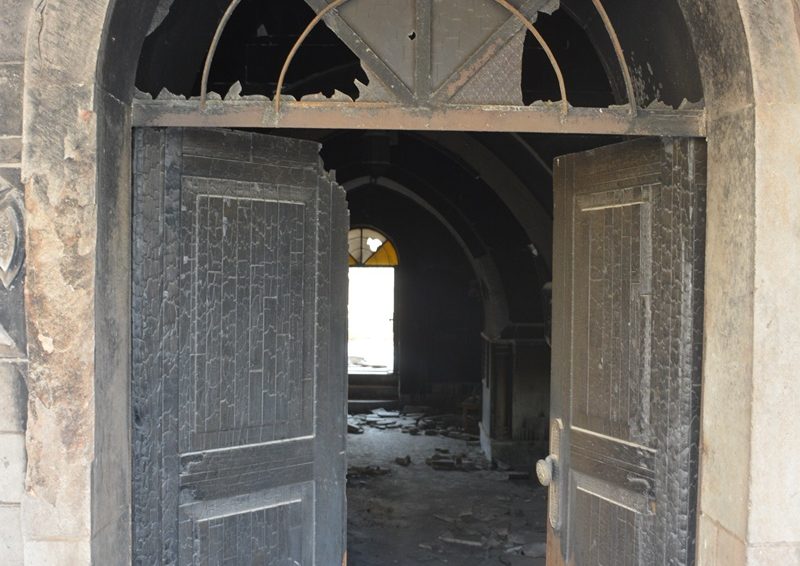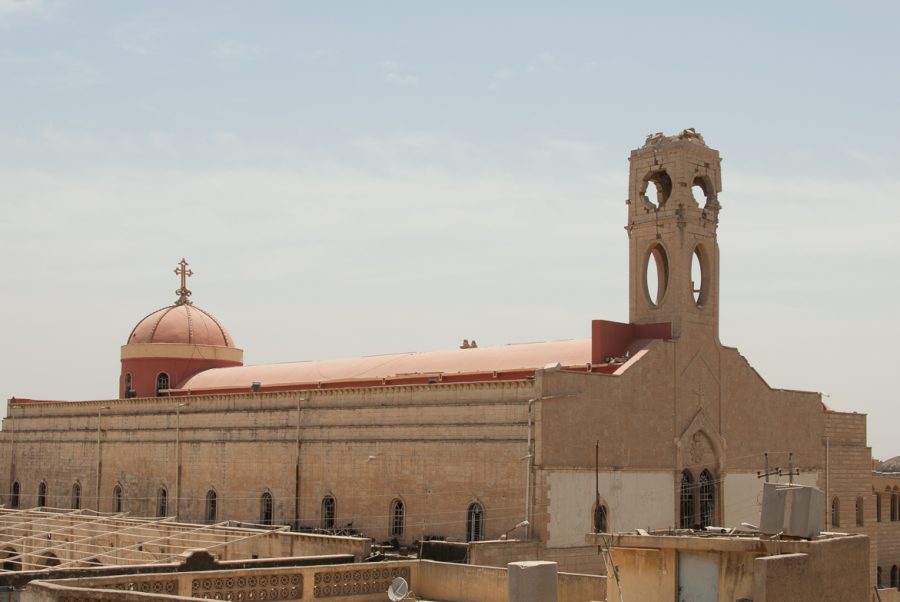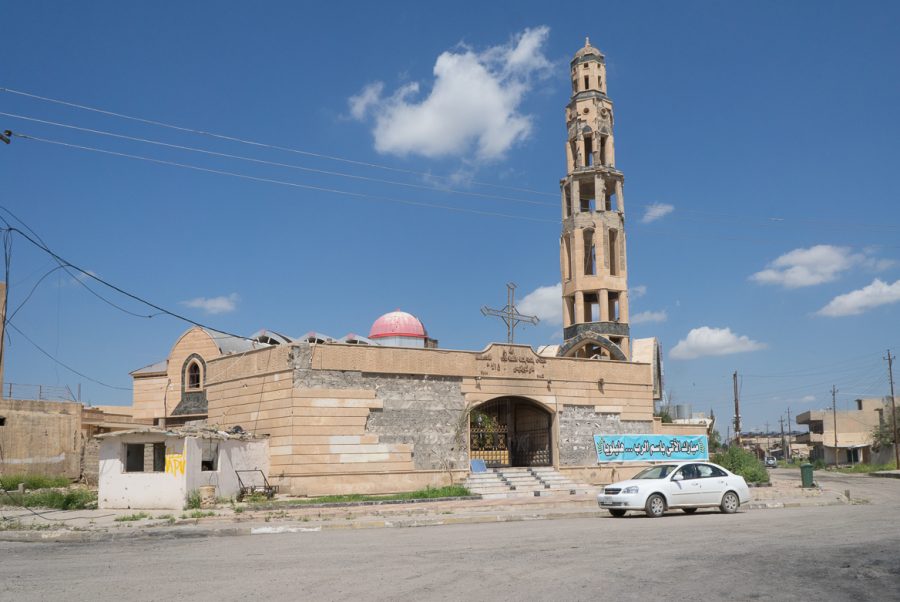Mar Sarkis and Bakus Church in Baghdede
The Syriac Orthodox church of Saints Sarkis and Bakus in Baghdede (Qaraqosh) lies 36°16’03.4″N 43°22’31.9″E and 273 metres high.
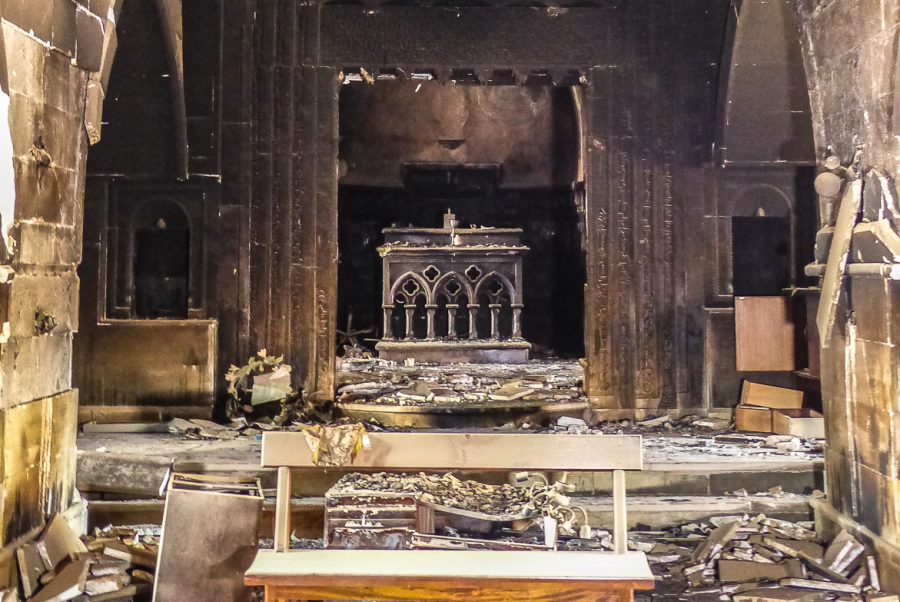
The Syriac Orthodox church of Saints Sarkis and Bakus is considered as one of the very first, if not the very first church erected in Baghdede. However its existence is only lately confirmed in a manuscript from the end of the 16thcentury.
This church deserves especially to be mentioned for its decorative earthenware and ceramic tiles from 15thor 16thcentury. Unfortunately, the church has endure severe sacking and burning by ISIS, and a massive cleaning work will have to be done to restore its radiance.
————————
Plan according to Suhayll Qash, modified, 1982, extract from « Les églises et monastères du Kurdistan irakien à la veille et au lendemain de l’islam », PhD thesis by Narmen Ali Amen. Saint Quentin en Yvelines University. May 2001, p.189
Location
The Syriac Orthodox church of Saints Sarkis and Bakus in Baghdede (Qaraqosh) lies 36°16’03.4″N 43°22’31.9″E and 273 metres high on a small hill. To get there, you need to take a street at a right angle to the main street, south of the town centre.
At the very heart of the Syriacs’ plain, Baghdede (Qaraqosh) lies 30 km southeast from Mosul and 80 km west from Erbil and is the largest Christian town of the Nineveh plain. It also lies 40 km upstream from the confluence between the Tigris River and the Great Zab. Some sort of community and denominational “capital city”, in a sense.
Baghdede toponymy
The name Qaraqosh, which in modern Turkish means Black Bird, is quite frequently used but its other and original name, Baghdede (Baghdeda) in Syriac language “probably comes from Bet Khudaydad which combines both semitic (Bet) and Persian (Khudaydad) origins [and which] means the place, the house given by God”[1]. This Syriac nameshould not be ignored as it seems to be the most in use nowadays.
_______
[1]Source Jean-Marie Mérigoux, O.P., in « L’Orient chrétien dans l’empire musulman », Collection Studia Arabica III, Editions de Paris, 2005.
Fragments of the Christian history of Baghdede
According to the tradition, Christianity entered the Nineveh plain and the city of Baghdede at the end of the 4thcentury or the beginning of the 5thcentury. More than likely, sources argue that evangelisation began in the 7thcentury. “The village was first Nestorian[1], then around 615 [it] became Monophysite[2]. In the 11thand 12thcentury, many Christians from Tikrit, before being forced to convert to Islam, left Tikrit and settled in Baghdede. In 1743, Nader Shah’s troops besieged the area, plundered Baghdede and destroyed the churches.
At that time, the villagers escaped to Mosul and took part in the defence of the town”[3]. Former Syriac-Orthodox see of the archbishopric, it is by the end of 18thcentury that the village became Catholic.
There are still several ancient Syriac-Catholic and Orthodox churches in nowadays Baghdede. All have been violated, sullied, plundered, even burnt by ISIS, all along the 26 months it occupied the city, from August 2014 to October 2016. Despite wreckages and destructions, some of these churches still stand firm against time and invaders and carry on being testament to this distant past.
Since the town was liberated in October 2016 and the returning of many inhabitants from April 2017 on, Baghdede is considered as an essential geographic pole for the Christian and Syriac revival in the Nineveh plain and throughout Mesopotamia.
_______
[3]Source Jean-Marie Mérigoux, O.P., in « L’Orient chrétien dans l’empire musulman », Collection Studia Arabica III, Editions de Paris, 2005.
Demography in Baghdede
It would be much risky to present some reliable statistics regarding the demography of this town (and of the whole country), as census is made impossible by successive wars and never-ending mass movements of population. Nevertheless, we can admit that at least 40 000 to 50 000 people used to live in Baghdede before ISIS attacked. Some probably overestimated statements, made by natives, mention about 70 000 inhabitants.
To these must be added thousands of displaced population (5 000 to 13 000 depending on the different phases), Christian people from Baghdad or Mosul who had settled in Baghdede from 2003 on, all running away from crimes and misdemeanours committed by terrorist or mafia groups that appeared after the Iraqi state collapsed and for whom great efforts had been provided with the aim of a long-lasting settlement.
Whatever the reality of demographical data, nearly 90 % of the inhabitants in Baghdede were Syriac-Catholics. The other 10 % were being split between Chaldeans (Catholic), Syriac-Orthodox, as well as a tiny apostolic Armenian community.
Before 1980, this city was said to be exclusively Christian. But afterwards, several tens of Muslim families progressively settled in, as part of the campaign of Arabisation of the Nineveh plain set up by Saddam Hussein.
History of the church of Saints Sarkis and Bakus in Baghdede
The date of the foundation of the Syriac-Orthodox church of Saints Sarkis and Bakus in Baghdede is not known, but the church is nevertheless considered as “the first one erected inQaraqōš, according to the fabulous legend of John of Dailam[1] .” Indeed according to Jean-Maurice Fiey, it is supposed to be one of the first Syriac-Orthodox churches in the city. This is historically and lately reported in a liturgical manuscript dated 1582[2]. Narmen Ali Amen, the archaeologist and historian expert in Kurdish-Iraqi Christianity, notes that “according to an inscription running on the doorframe, the church was rebuilt in 1744 by the bishopĪwānīs[3]and was partially restored in 1843[4]”.
________
[1]In « Assyrie chrétienne », , Jean-Maurice Fiey, Beyrouth, 1965, p.458
[3]Jean-Maurice Fiey indicates that the bishop Īwānīs Kārés was prior at Mar Behnam monastery, buried in that place, and he was also and above all the head of the village of Baghdede.
[4]In « Les églises et monastères du Kurdistan irakien à la veille et au lendemain de l’islam », PhD thesis by Narmen Ali Amen. Saint Quentin en Yvelines University. May 2001, p.187. Quoted source : Jean-Maurice Fiey, in « Assyrie chrétienne », Beyrouth, 1965, p.458-460
Description of the church of Saints Sarkis and Bakus in Baghdede
On the side facing the street, north, you can access the church through a slightly pointed-arched modern gate. Inside the religious compound, the church of Saints Sarkis and Bakus looks relatively small. All around is “a courtyard, oriented eastwards, and which also seems large, if not even larger than the church[1]”. From the outside, this ancient church has been restored with modern materials: concrete blocks, concrete and white stone facing, typical of late 20thcentury renovations.
Inside, after getting through the doors for either men or women on the southern facade, the church has a basilica-shape with 1 nave, 2 side-aisles and 4 bays, at the east of which stands the chevet, showing a protruding apse topped by a cupola. This is a very typical architecture for western Assyrian, Syriac-Orthodox and Catholic churches, with the sanctuary (Holy of Holies) eastwards oriented and consisting in 3 parts. In the centre, backing onto the apse’s wall stands the high altar with steps. It has open accesses to both side rooms: the martyrion (bēt sōhdēin Syriac language) on the north, the sacristy (bēt diāqōn) and the baptismal fonts(bēt ma’mudītō) on the south.
The nave and the two side-aisles are separated from the sanctuary by three carved doors. The royal (or holy) door, in the centre, has a decorative “lintel bearing a cross trefly (trefoiled cross) under a three-parts discharging arch[2]”.
Ornemental ceramic and earthenware tiles also deserve attention. Dated from the 15thor 16thcentury, they were embedded in the church’s wall, before ISIS attacked and sacked it. They were “rare examples that could be found in only two churches in Qaraqōš[3]”.
________
[1]As observed by Pauline Bouchayer (Mesopotamia) late December 2017.
[2]In « Les églises et monastères du Kurdistan irakien à la veille et au lendemain de l’islam », PhD thesis by Narmen Ali Amen. Saint Quentin en Yvelines University. May 2001, p.187. Quoted source : PREUSSER, 1911.
[3]In « Les églises et monastères du Kurdistan irakien à la veille et au lendemain de l’islam », PhD thesis by Narmen Ali Amen. Saint Quentin en Yvelines University. May 2001, p.188.
News from the church of Saints Sarkis and Bakus in Baghdede
Devastated by ISIS, the church of Saints Sarkis and Bakus « looks like being frozen since the town was liberated[1] » and even more as “less than 150 Syriac-Orthodox families returned[2]” and no Syriac-Orthodox priest has (yet) returned for this community.
Even before getting into the church, the courtyard shows consternation and despair. In its centre, an olive tree with scattered green branches still stands up, whereas the ground was, in January 2018, still littered by bits and pieces and varied things. A thick, ochre dust layer, typical of local storms, covers everything.
The 3-steps marble stair is covered with torched debris. Down the steps, the church appears fully blackened and heavily damaged. Several fires were probably lit within the church. The marble facing exploded here and there due to high temperatures. Metal storage cabinets were thrown upside down on the floor, deformed metal office chairs are piled up together with melted PC-keyboards.
Moving forward towards the chancel, a feeble light comes downwards from the openings in the cupola. You need to walk up two steps to reach the sanctuary, dedicated to servants and priests.
Fortunately, the royal door carved with ancient patterns, has not been damaged. On the contrary, all bas-reliefs are covered with a thick layer of soot, as a scar left by the fire.
Beyond this door, we can still see the stone high altar with steps, with the chalice standing on the communion table.
In the right side-aisle, the part of the wall right of the altar is partially destroyed, at the very same place where coloured ceramic plates with cross patterns were kept since the 12thcentury. They were probably still lying on the floor under the rubble, when MESOPOTAMIA[3]and KTO[4]visited the place in January 2018.
This church is very old, it is of 6th century.
As of July 23, 2019, nearly three years after the liberation of the Nineveh plain, the church of Saints Serge and Bacchus has not yet been cleaned or even restored.
Father Theophilos, Syriac-Orthodox parish priest of Baghdede, appeals for help in the restoration of this important heritage building.
_________
[1]As observed by Pauline Bouchayer (Mesopotamia) late December 2017.
Monument's gallery
Monuments
Nearby
Help us preserve the monuments' memory
Family pictures, videos, records, share your documents to make the site live!
I contribute